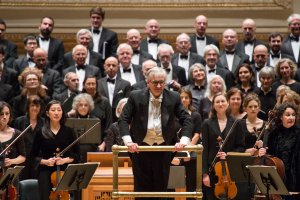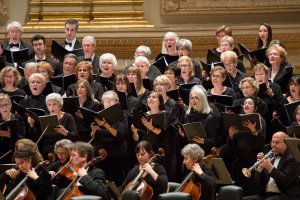The Cecilia Chorus of New York with Orchestra: Ludwig van Beethoven, Missa Solemnis, Op. 123
Beethoven's monumental choral mass, sturdily and effectively presented with moments of lovely revelation and graceful brilliance.

The Cecilia Chorus of New York with conductor Mark Shapiro and orchestra
[avatar user=”Jean Ballard Terepka” size=”96″ align=”left” ] Jean Ballard Terepka, Music Critic[/avatar]The sheer monumentality of Beethoven’s Missa Solemnis exacts courage and discipline from both performers and listeners. In its physical and technical demands on singers and instrumentalists and in the sweep of its genius, it is a huge work. The recent May 2016 performance of this work by the Cecilia Chorus of New York provided the audience with a sturdy rendition of the Missa, ranging in the quality of its execution from competence to revelation, and offering a welcoming entrance into rich, demanding complexities of the piece.
For this performance, Mark Shapiro, now in his fifth season as the Cecilia Chorus conductor, directed the full chorus of more than 150 singers, orchestra of close to 50 instrumentalists, and four exceptionally fine soloists, Christine Taylor Price (soprano), Amanda Lynn Bottoms (mezzo-soprano), Alex Richardson (tenor) and Andre Courville (bass-baritone).
The initial occasion for Beethoven’s Missa Solemnis was traditional: he first conceived the piece to honor the investiture of his friend Rudolph, Archduke of Austria as Archbishop, in 1820, though he did not in fact complete it until three years later. The work has the text, shape and structure of a formal liturgical mass. But the sheer forces of production called for in the score – everything from the length of the movements to the intensity of the more-than-fortissimo, “fff,” dynamics indications – make it more an exposition of the meanings of theological texts than a musical accompaniment to an actual liturgy.
The opening Kyrie movement, though the shortest and in some respect the most historically traditional of the work’s five sections, serves not so much as a declaration of the clergy’s arrival and the service’s beginning, as an invitation to listeners to attend to what is to come: in Shapiro’s hands, the Kyrie functioned like a foreword, an introduction to an extended discourse. The gentle, balanced orchestral opening was a generous invitation to singers and audience alike; once the chorus proclaimed, “Kyrie!” the religious text – and Christianity’s full subject of promise, loss, anguish and salvation – was introduced.

Conductor Mark Shapiro
The brief Christe section presented the first of what would be this performance’s several successes: when both soloists and chorus sang, the balance of individual voices rising from the context of collective singing was consistently clear and responsible, artistically embodying the sacred text’s individual meanings within the context of humanity’s yearnings.
The Gloria was appropriately huge. Occasionally, though the sheer sound of the orchestra and the sound of the chorus were well blended, the volume made the text hard to understand. (Diction in the Cecilia Chorus is sometimes unclear, but it was difficult to tell here whether the problem in understanding the words lay in an imbalance between orchestra and chorus or in choristers’ inattentiveness to consonants.) The soloists’ brief Gratias quartet was graceful and dancelike; later in the movement, their ornate, urgent and demanding Amen with the chorus was bracing and exciting. The audience applause might have made one think the work had reached its conclusion.
The third movement, the Credo, offered both the evening’s greatest weaknesses as well as its strengths. In spite of Shapiro’s observation in the program notes that a Missa Solemnis performance should never succomb to mere “literal loudness,” there were moments in the Credo when the sheer relentlessness of sound blurred the work’s subtleties. In contrast, though, in the more narrative portions of the Nicene Creed’s proclamations, when the chorus was allowed to tell the foundational story from Jesus’ miraculous birth through to his execution and final triumphant resurrection, the music was gorgeously effective.
After intermission, the work resumed with its most consistently successfully performed movements. The Sanctus was wonderfully beautiful. Much of the credit here goes to the unidentified solo violinist – presumably concertmaster Deborah Wong, who stood forward from the violin section to perform – who played exquisitely, making of her instrument a voice of prayer that was an equal partner with the vocal soloists. The dynamically nuanced choral Osanna at the end of the movement seemed an appropriately inevitable offering of grateful praise for the brilliant presence of the one who walks in the name of the Lord.

The Cecilia Chorus of New York and orchestra
The final Agnus Dei is, in many ways, the most innovative section of the whole Missa Solemnis. In its architecture, it moves performers and listeners alike away from the format of the mass to a full choral symphony while also illuminating the ultimate unity of personal and universal desires for peace. The soloists are individual people here: they are neither voices embodying individual sacred-text statements nor stand-ins for different kinds of humanity as they had been throughout the first four movements.
Price, Bottoms, Richardson and Courville are all strong, clear singers; they were well matched in this performance, alert to each other’s pacing and responsive to each other’s sensibilities. Although any one of the four could have grabbed a center spotlight, they were unified – probably by a combination of their own individual understandings of Beethoven’s purposes and by Shapiro’s direction – in graceful collaborative cohesion in their singing.
The famous conclusion of the Agnus Dei – the huge expectation that peace will ultimately reign, moving in sound and feel from martial determination to pastoral gentleness – is an assertion not limited to Christian theology but of creative, universal triumph. The demand to God – “Dona!” – half an insistence for the future and half a declaration of what is possible in this present moment – in Shapiro’s hands was thrilling.
Beethoven’s Missa Solemnis contains references and allusions to Christian sacred music traditions that extend from medieval chant to Beethoven’s immediate predecessors, colleagues and contemporaries; this historical sweep explains, in part, the work’s weight and power. It also, in its density and grandeur, anticipates the sacred works of Mahler and the great Requiems of Brahms, Berlioz and Verdi. No single performance, whether even better than this one or much weaker, can hope to present all of the work’s complex beauty. The fact that the Cecilia Chorus presented so much of its magnificence as successfully as it did served both Beethoven and the audience well.
The Cecilia Chorus of New York with Orchestra: Ludwig van Beethoven, Missa Solemnis, Op. 123 (May 6, 2016)
Carnegie Hall
881 Seventh Avenue, at 57th Street, in Manhattan
For more information: call 646-638-2535 or see http://www.ceciliachorusny.org
Running time: one hour and 45 minutes with one intermission






Leave a comment